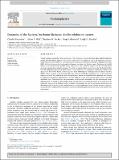| dc.contributor.author | Faccenna, Claudio | |
| dc.contributor.author | Holt, Adam F. | |
| dc.contributor.author | Becker, Thorsten W. | |
| dc.contributor.author | Lallemand, Serge | |
| dc.contributor.author | Royden, Leigh H | |
| dc.date.accessioned | 2020-06-18T13:35:29Z | |
| dc.date.available | 2020-06-18T13:35:29Z | |
| dc.date.issued | 2018-10 | |
| dc.date.submitted | 2017-08 | |
| dc.identifier.issn | 0040-1951 | |
| dc.identifier.uri | https://hdl.handle.net/1721.1/125860 | |
| dc.description.abstract | Trench motions represent the surface expression of the interaction between subducting plates and the underlying mantle, but the inherent dynamics are not fully understood. One interesting case is the migration of the Izu-Bonin-Marianas trench (IBM) that accommodates the subduction of the Pacific beneath the Philippine Sea Plate (PSP), which is in turn subducting beneath the Eurasian plate along the Ryukyu trench. The history of the IBM trench is dominated by fast, episodic retreat from 40 to 15 Ma. However, around 10–5 Ma, the IBM trench reversed its motion from retreat to advance. The switch in trench motion occurred soon after the breakoff of the PSP slab along the Ryukyu trench and the onset of new subduction, and represents a fundamental change in the dynamics of the western Pacific subduction zones. Here, Following the modelling study of Čížková and Bina (2015), which suggested a link between IBM trench advance and Ryukyu subduction, we run 2-D numerical experiments to test the influence of a newly formed Ryukyu slab on the established IBM subduction zone, we run two-dimensional numerical experiments to test the influence of this newly formed Ryukyu slab on the IBM subduction zone. The results from our geodynamic model compare favourably with the reconstructed trend, indicating that the switch in trench motion along the IBM trench may indeed be related to the onset of a new subduction zone along the Ryukyu trench. Our analysis substantiates the idea that advancing trench motions in the western Pacific are due to the establishment of a double subduction system. Further analysis of such dynamics provides insights for the mechanisms controlling subducting plate and trench motions and mantle force transmission. | en_US |
| dc.language.iso | en | |
| dc.publisher | Elsevier BV | en_US |
| dc.relation.isversionof | http://dx.doi.org/10.1016/j.tecto.2017.08.011 | en_US |
| dc.rights | Creative Commons Attribution-NonCommercial-NoDerivs License | en_US |
| dc.rights.uri | http://creativecommons.org/licenses/by-nc-nd/4.0/ | en_US |
| dc.source | other univ website | en_US |
| dc.title | Dynamics of the Ryukyu/Izu-Bonin-Marianas double subduction system | en_US |
| dc.type | Article | en_US |
| dc.identifier.citation | Faccenna, Claudio et al. "Dynamics of the Ryukyu/Izu-Bonin-Marianas double subduction system." Tectonophysics 746 (October 2018): 229-238 © 2017 Elsevier B.V. | en_US |
| dc.contributor.department | Massachusetts Institute of Technology. Department of Earth, Atmospheric, and Planetary Sciences | en_US |
| dc.relation.journal | Tectonophysics | en_US |
| dc.eprint.version | Author's final manuscript | en_US |
| dc.type.uri | http://purl.org/eprint/type/JournalArticle | en_US |
| eprint.status | http://purl.org/eprint/status/PeerReviewed | en_US |
| dc.date.updated | 2019-09-26T15:43:40Z | |
| dspace.date.submission | 2019-09-26T15:43:42Z | |
| mit.journal.volume | 746 | en_US |
| mit.license | PUBLISHER_CC | |
| mit.metadata.status | Complete | |
